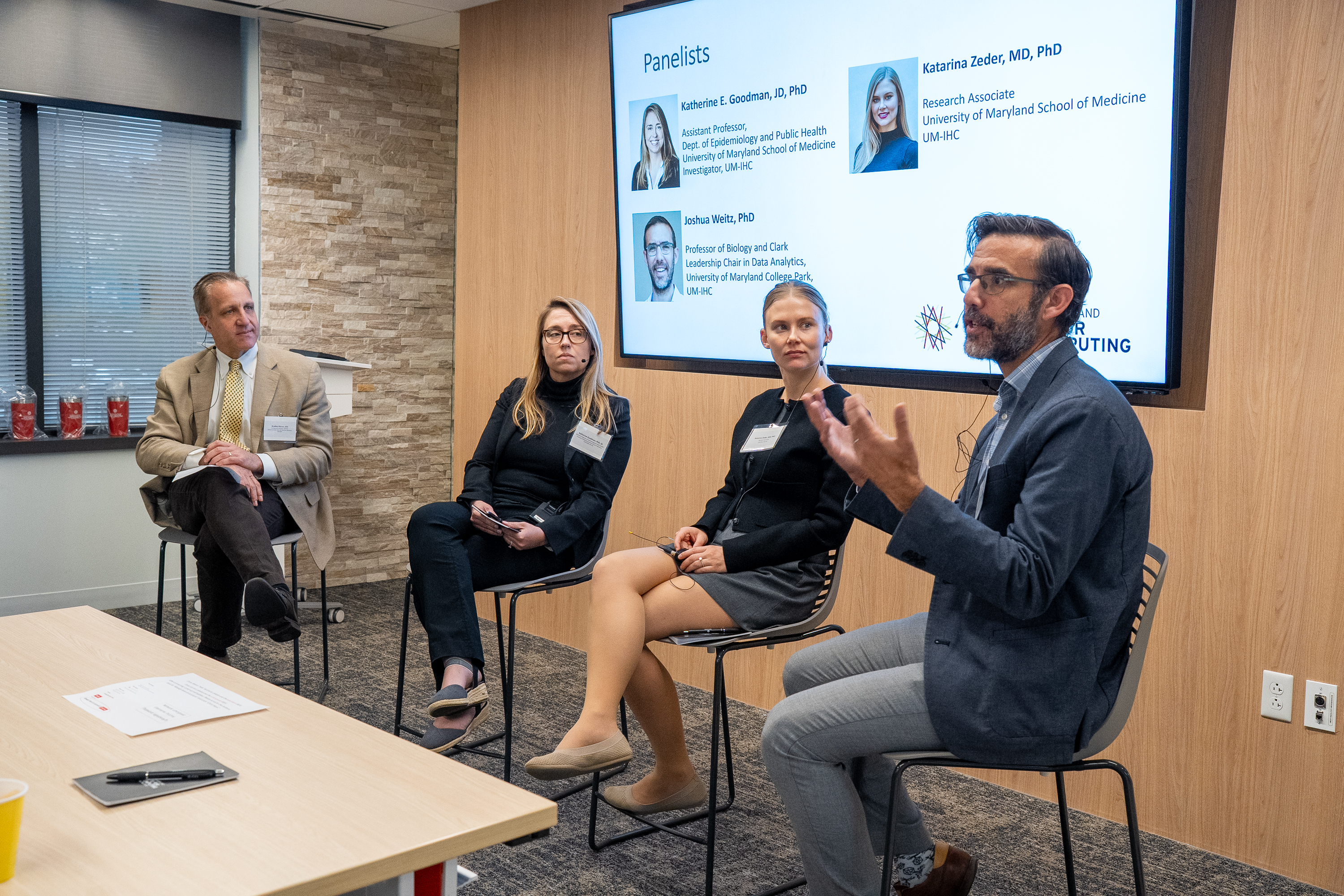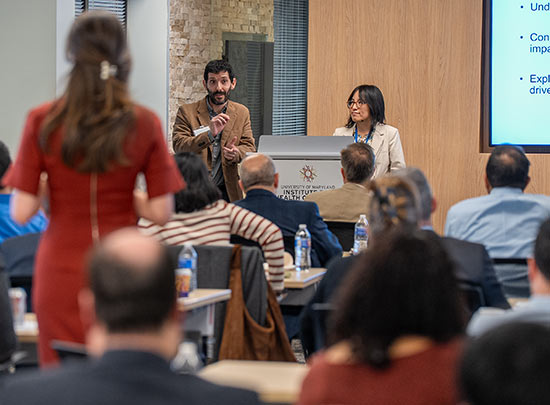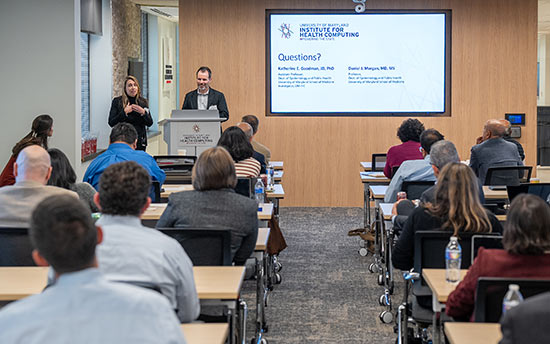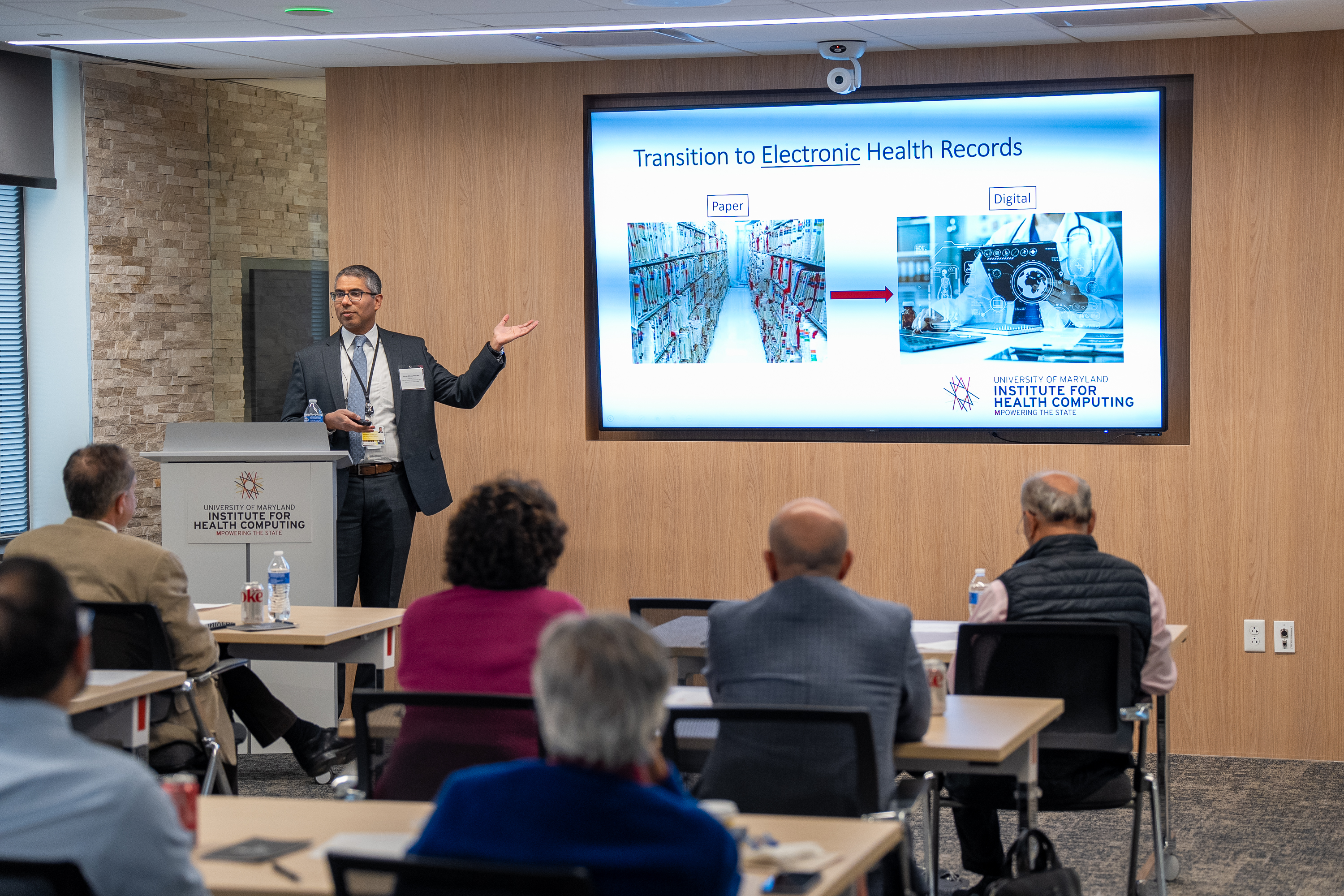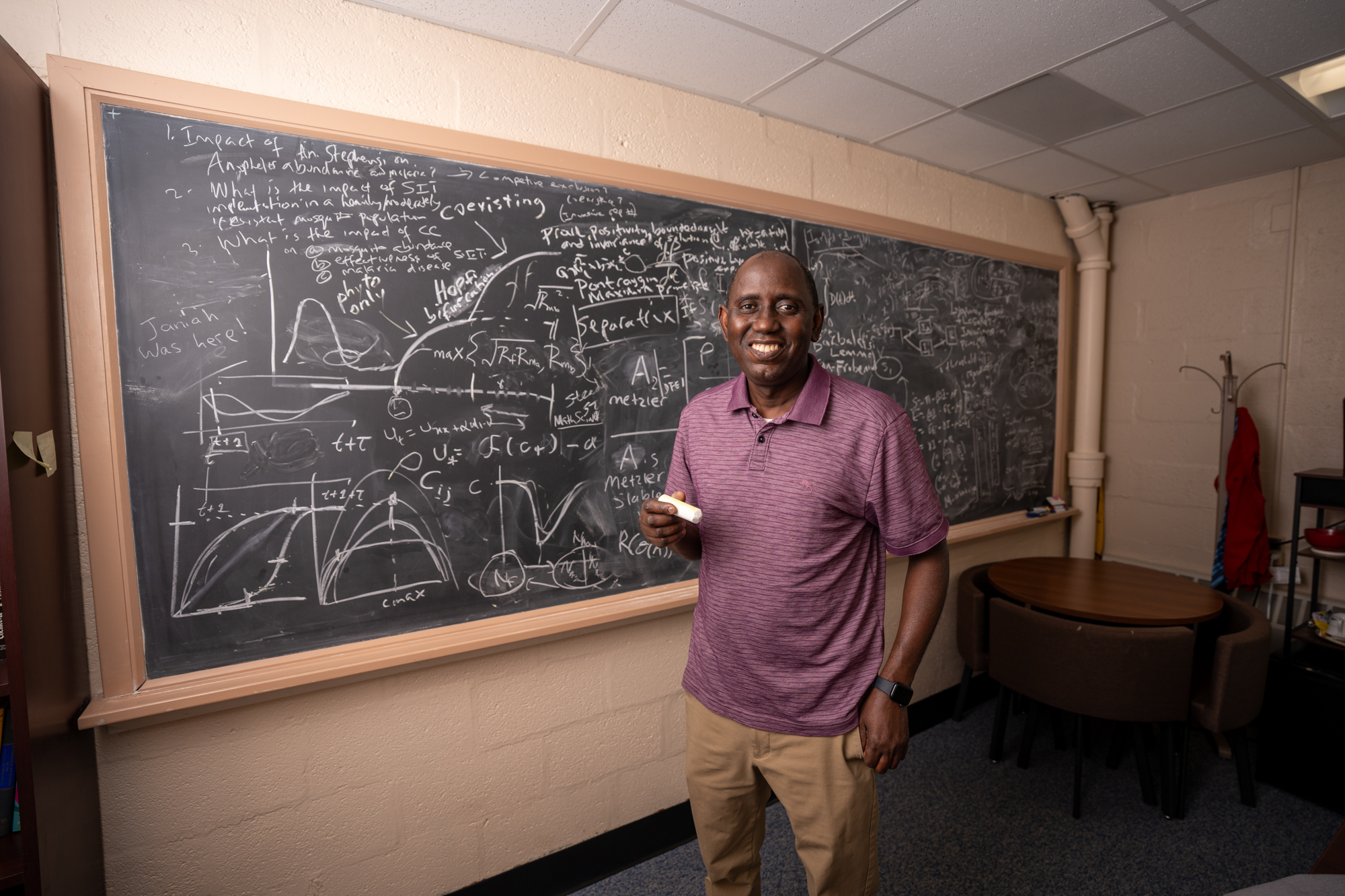UM-IHC Launches Continuing Medical Education Program

Conference organizers pictured from left to right: Bradley Maron, Alexandria Ratzki-Leewing, Katherine Goodman, Florence Xini Doo, Katarina Zeder, Joshua Weitz, and Warren D’Souza.
Published on the UMSOM website, Adapted for the MPower website | November 11, 2025
The University of Maryland Institute for Health Computing (UM-IHC) held its first-ever Continuing Medical Education (CME) course on October 28 for healthcare practitioners in a daylong session held on their campus. The topic focused on the use of artificial intelligence (AI) in healthcare.
“This inaugural session represents an exciting step toward building a broader CME initiative at UM-IHC—one that empowers clinicians and researchers to navigate, and lead within, the rapidly evolving world of AI in medicine,” said CME Director, Alexandria Ratzki-Leewing, PhD, UM-IHC faculty and University of Maryland Medical School (UMSOM) Assistant Professor of Epidemiology & Public Health.
More than 40 clinical professionals gathered in a sunlit conference room in the Institute’s North Bethesda headquarters for an afternoon of presentations and discussions on the development of AI tools for the clinic and strategies for shaping their responsible, equitable, and impactful use.
Launched in 2022, the UM-IHC leverages the power of large-scale data science, including AI, to address the biggest generational challenges in healthcare, and researches how computational technologies can be applied to biomedical science.
The UM-IHC developed and is now offering the new CME session in AI because “AI tools are not only rapidly evolving, but they are already being deployed in clinical settings, such as at University of Maryland Medical Center (UMMC),” said Bradley Maron, MD, Melvin Sharoky, MD Professor of Medicine and Co-Executive Director of UM-IHC. “But the pace of AI development is outrunning the practical training needed by the clinicians who must use it. To realize the full potential of these tools, we need to equip practitioners with the knowledge to responsibly and successfully integrate them.”
“I think this information is really needed within the University of Maryland Medical System (UMMS),” said participant Megan Anders, MD, MS, UMSOM Associate Professor of Anesthesiology and Vice Chair for Safety and Quality in Anesthesiology. “I came because there is a tremendous amount of both potential and current use of AI across the system, and there’s an opportunity for getting people the education they need to implement and research with this technology responsibly.”
Many clinicians are already using AI in their practices. In a recent survey of American College of Radiology members, 33 percent said they adopted AI radiology tools immediately as they became available, and 20 percent predicted they would use them in the next five years, said Florence Xini Doo, MD, a UMSOM Assistant Professor of Diagnostic Radiology and Nuclear Medicine, and Director of Innovation for the Medical Intelligent Imaging (UM2ii) Center. She was one of eight UM-IHC faculty members presenting at the event. “Over half of radiologists are using AI on clinical images today,” she said.
A Taxonomy of AI in the Clinic
AI tools in healthcare fall into two main categories, according to Katherine Goodman, PhD, JD, UMSOM Assistant Professor of Epidemiology & Public Health, who provided a taxonomy of the AI tools already in use or in development. Many tools currently used in the clinic are forms of predictive AI, technologies that mostly take numerical inputs, such as vital signs, and produce numerical outputs, such as risk scores, she said. Many predictive AI technologies might not have been called “AI” until recently, Dr. Goodman added, with the exception of the powerful image analysis tools used in radiology.
In the second, newer category of AI are generative AI tools, Dr. Goodman said, which include the Large Language Models (LLMs) such as ChatGPT and Google Gemini. More flexible than predictive AI, generative AI takes natural, human language inputs and produces outputs that read as human, enabling applications such as ambient scribes, software that listens to clinician-patient interactions and automatically produces notes for the clinician.
Ambient scribes are currently used in millions of annual visits in the U.S., and the same technology could soon power more flexible pre-visit patient screening, resource allocation analysis on a healthcare systems-wide scale, and, eventually, assist clinicians in making differential diagnoses, according to presentations by Daniel Morgan, MD, MS, UMSOM Professor of Epidemiology & Public Health and Director of the Center for Innovation in Diagnosis, and Jonathan Baghdadi, MD, PhD, UMSOM Associate Professor of Epidemiology & Public Health. Katarina Zeder, MD, PhD, a faculty member at UM-IHC, also participated in a panel discussion at the event.
The Challenges Facing Transformational AI in Healthcare
The presenters also discussed the limitations and potential challenges of using generative AI tools in the clinic. “Data is really the food or fuel for AI,” said Warren D’Souza, PhD, MBA, FAAPM, UM-IHC Co-Director and Senior Vice President and Chief Innovation Officer for UMMS, which makes access to Electronic Health Records crucial for the development of impactful generative AI tools. But ensuring AI access to patient records is HIPAA law-compliant is an active area of research at UM-IHC, he added, which works with the UMMS EHR database.
They also cautioned about caveats: Significant work remains for both biomedical researchers and AI developers to ensure the technologies can be trusted to produce accurate responses, AI technologies are known to sometimes “hallucinate,” for example, confidently presenting responses that appear factual but are not necessarily evidence-based, according to Joshua Weitz, PhD, Professor of Biology and Clark Leadership Chair in Data Analytics at the University of Maryland, College Park (UMCP).
“We keep talking about AI technologies as if they are magical tools,” he said. “But these tools are evolving and have flaws.” The challenge is for healthcare providers to learn both how to most effectively use AI tools and how to identify and recognize flaws, while the larger, systemic challenge is building a relationship between providers, healthcare systems, and AI developers that ensures the technologies continue to improve.
“It’s not enough to build these tools,” said Adam Porter, PhD, UMCP Professor of Computer Science and Co-Executive Director for UM-IHC. “We must empower the clinical workforce to gain the practical expertise required to critically appraise, ethically deploy, and safely manage AI systems. That is how we unlock the true value of AI in medicine.”
About UM-IHC
A strategic initiative of the University of Maryland Strategic Partnership: MPowering the State (MPower), UM-IHC is a partnership between the University of Maryland, Baltimore, the University of Maryland, College Park (UMCP), and the University of Maryland Medical System (UMMS). UM-IHC leverages top-tier computational expertise, biomedical research, and a vast, geographically diverse clinical care network to improve well-being, quality of life, diminish disease, and enhance health outcomes for all citizens of Maryland and beyond. For more information visit ihc.umd.edu.
About the University of Maryland School of Medicine
The University of Maryland School of Medicine, established in 1807 as the first public medical school in the U.S., continues today as one of the fastest growing, top-tier biomedical research enterprises in the world. The School has nearly $500 million total research funding, 46 departments, centers, and institutes, more than 2,200 student trainees and over 3,000 faculty members, including notable members of the National Academy of Medicine. As the largest public medical school in the DC/MD/VA region, faculty-physicians are working to help patients manage chronic diseases like obesity, cancer, heart disease and addiction, while also working on cutting-edge research to address the most critical generational health challenges. In 2024, the School ranked #12 among public medical schools and #27 among all medical schools for R&D expenditures by the National Science Foundation. With a $1.3 billion total operating budget, the School partners with the University of Maryland Medical Center to serve nearly 2 million patients annually. The School’s global reach extends around the world with research and treatment facilities in 33 countries. In Maryland, the School of Medicine is spearheading new initiatives in AI and health computing and partnering with the University of Maryland BioPark to develop new medical technologies and bioengineering ventures. For more information, visit medschool.umaryland.edu.

